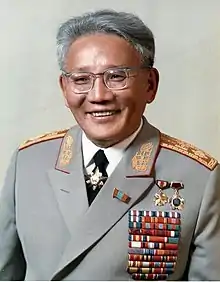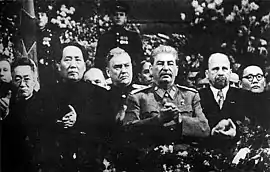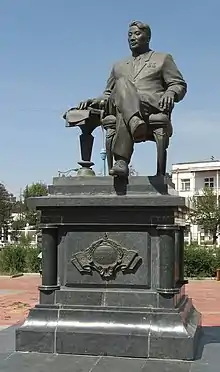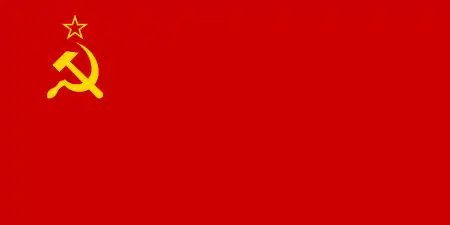Yumjaagiin Tsedenbal
Yumjaagiin Tsedenbal (Mongolian: Юмжаагийн Цэдэнбал,[lower-alpha 1] Jumƶaagiin Cedenbal [jumt͡ʃɑɡiːŋ t͡sʰɪtənpɑɮ]; Russian: Юмжагийн Цэдэнбал, romanized: Yumjagyn Tsedenbal [jʊmʐɐˈɡɪjn t͡sɪdɪnˈbɑɫ]; 17 September 1916 – 20 April 1991) was the leader of the Mongolian People's Republic from 1940 to 1984. During his political life, he served as Chairman of the Presidium of the People's Great Khural (head of state), Prime Minister of Mongolia (head of government) and General Secretary of the Mongolian People's Revolutionary Party. He was the longest-serving leader of any Eastern Bloc country, serving over 44 years in office until his expulsion in August 1984.
Yumjaagiin Tsedenbal Юмжаагийн Цэдэнбал ᠶᠠᠭᠤᠮᠠᠵᠢᠭᠠ ᠶᠢᠨ ᠼᠡᠳᠡᠨᠪᠠᠯ | |
|---|---|
 | |
| Chairman of the Presidium of the People's Great Khural | |
| In office 11 June 1974 – 23 August 1984 | |
| Preceded by | Sonomyn Luvsan (acting) |
| Succeeded by | Nyamyn Jagvaral (acting) |
| 11th Chairman of the Council of Ministers | |
| In office 26 January 1952 – 11 June 1974 | |
| Preceded by | Khorloogiin Choibalsan |
| Succeeded by | Jambyn Batmönkh |
| General Secretary of the Mongolian People's Revolutionary Party | |
| In office 22 November 1958 – 24 August 1984 | |
| Preceded by | Dashiin Damba |
| Succeeded by | Jambyn Batmönkh |
| In office 8 April 1940 – 4 April 1954 | |
| Preceded by | Dashiin Damba |
| Succeeded by | Dashiin Damba |
| Personal details | |
| Born | 17 September 1916 Davst sum, Uvs aimag, Outer Mongolia |
| Died | 20 April 1991 (aged 74) Moscow, Russian SFSR, Soviet Union |
| Political party | Mongolian People's Revolutionary Party (1936-1984) |
| Spouse(s) | Anastasia Filatova |
| Children | Vladislav Zorig |
| Military service | |
| Allegiance | |
| Branch/service | |
| Years of service | 1936-1984 |
| Rank | |
Early life
Tsedenbal was born to a poor ethnic Dörvöd nomadic family in Zorigt Khan hoshuu of the Unen Zorigt Khan aimag (present day Davst sum in Uvs aimag). He was the fifth of eleven children in his family (three of his siblings died in infancy).
In 1925 Tsedenbal became among the first students in the newly organized public school in Ulaangom, graduating in 1929. The same year Tsedenbal went to Irkutsk to continue his education. He spent about nine years between Irkutsk and Ulan-Ude, where he learned the Russian language and later obtained a degree from the Siberian Finance and Economics Institute.
Career

In 1939, having returned to Ulaanbaatar, Tsedenbal worked first as a deputy minister, and then as the Minister of Finance from 1939 to 1940.[1] Additionally, he was the governor of Bank of Mongolia at that time.[2] In 1940, at the 10th Congress of the Mongolian People's Revolutionary Party, he became the party's General Secretary at age 23 and again in 1958 during his premiership.
After taking over minor leadership in 1952 following Marshal Khorloogiin Choibalsan's death, Tsedenbal successfully purged his political rivals: Dashiin Damba in 1958–59, Daramyn Tömör-Ochir in 1962, Luvsantserengiin Tsend in 1963, and the so-called Lookhuuz-Nyambuu-Surmaajav "anti-party group" in December 1964. He held this office until 11 June 1974, when he eventually became head of state, thus making him the supreme ruler of the Mongolian People's Republic.
His foreign policy was marked by efforts to bring Mongolia into ever-closer cooperation with the USSR. Still, Tsedenbal and his group of party leaders (such as Tsagaan-Lamyn Dugersuren and Damdinjavyn Maidar) were dissatisfied with the economic role that the Soviet leadership assigned to Mongolia. While the USSR prodded the Mongolian government to concentrate its efforts on the development of agriculture and the mineral sector, Tsedenbal and his followers sought to foster rapid industrialization even in the face of Soviet opposition.[3] At the same time, Tsedenbal was cautious enough to frequently express his loyalty to the Kremlin and portray his intra-party critics—including Daramyn Tömör-Ochir, Tsogt-Ochiryn Loohuuz, and others—as "pro-Chinese factionalists" and "nationalists."[4]

With the full backing of the Soviets, Tsedenbal successfully purged his political opponents. During his reign as head of the state, Tsedenbal submitted requests for the incorporation of Mongolia into the USSR on five to eight occasions, but these proposals were invariably rejected by the Soviet leaders. At the time of the Sino-Soviet split, Tsedenbal decisively sided with the Soviet Union and incurred China's wrath. In Mongolia, Tsedenbal is remembered for successfully maintaining a path of relatively moderate socialism during the Cold War.
Tsedenbal was forced into retirement in August 1984 in a Soviet-sponsored move, officially on the account of his old age and mental weakness but at least partly because of his opposition to the process of Sino-Soviet rapprochement that had started with Leonid Brezhnev's Tashkent speech in March 1982. Jambyn Batmönkh became the general secretary of the MPRP. Tsedenbal was removed a month after receiving Chairman of the Vietnamese Council of State Trường Chinh and just days away before he was due to attend a ceremony in honor of the 45th anniversary of the Soviet-Mongolian victory in the Battle of Khalkhin Gol.[5]
Tsedenbal remained in Moscow until his death; his body was brought to Mongolia, where it was buried.
Legacy

His Russian wife, Anastasia Filatova (Анастасия Филатова), was often said to be the most powerful political figure in Mongolia due to her close relationship with the Soviet leader Leonid Brezhnev.
A statue of Tsedenbal was built in 2000 on the plaza in front of the National Drama Academic Theater which has since been renamed to Tsedenbal Square (Цэдэнбалын талбай). The statue and its surroundings were refurbished in 2013.[6]
In 2019, Mongolian filmmakers produced a biographical film of Tsedenbal.[7]
Awards
.svg.png.webp) Mongolian People's Republic:
Mongolian People's Republic:
 Hero of the Mongolian People's Republic (1966)
Hero of the Mongolian People's Republic (1966) Hero of Labor of the Mongolian People's Republic (1961)
Hero of Labor of the Mongolian People's Republic (1961) 5 Orders of Sukhbaatar
5 Orders of Sukhbaatar 2 Orders of the Red Banner
2 Orders of the Red Banner Order of the Red Banner of Labor
Order of the Red Banner of Labor Order of Friendship
Order of Friendship Medal "For Victory over Japan"
Medal "For Victory over Japan" Medal "30 year anniversary of the Victory over Japan"
Medal "30 year anniversary of the Victory over Japan" Medal "25th Anniversary of Mongolian People's Revolution"
Medal "25th Anniversary of Mongolian People's Revolution" Medal "30 year anniversary of the Battle of Khalkhin Gol"
Medal "30 year anniversary of the Battle of Khalkhin Gol" Medal "40 year anniversary of the Battle of Khalkhin Gol"
Medal "40 year anniversary of the Battle of Khalkhin Gol" Medal "50 years of the Mongolian People's Republic"
Medal "50 years of the Mongolian People's Republic" Medal "50 years of the Mongolian People's Army"
Medal "50 years of the Mongolian People's Army"
 Soviet Union:
Soviet Union:
 3 Orders of Lenin (1944, 1976, 1986)
3 Orders of Lenin (1944, 1976, 1986) Order of the October Revolution
Order of the October Revolution Order of Kutuzov, 1st class
Order of Kutuzov, 1st class Medal "For the Victory over Germany in the Great Patriotic War 1941–1945"
Medal "For the Victory over Germany in the Great Patriotic War 1941–1945" Medal "For the Victory over Japan"
Medal "For the Victory over Japan" Jubilee Medal "In Commemoration of the 100th Anniversary of the Birth of Vladimir Ilyich Lenin"
Jubilee Medal "In Commemoration of the 100th Anniversary of the Birth of Vladimir Ilyich Lenin" Jubilee Medal "Twenty Years of Victory in the Great Patriotic War 1941-1945"
Jubilee Medal "Twenty Years of Victory in the Great Patriotic War 1941-1945" Jubilee Medal "Thirty Years of Victory in the Great Patriotic War 1941–1945"
Jubilee Medal "Thirty Years of Victory in the Great Patriotic War 1941–1945" Jubilee Medal "50 Years of the Armed Forces of the USSR"
Jubilee Medal "50 Years of the Armed Forces of the USSR" Jubilee Medal "60 Years of the Armed Forces of the USSR"
Jubilee Medal "60 Years of the Armed Forces of the USSR"
- Other countries:
 2 Orders of Georgi Dimitrov (Bulgaria)
2 Orders of Georgi Dimitrov (Bulgaria) Order of Jose Marti (Cuba)
Order of Jose Marti (Cuba) Order of the White Lion, 1st class (Czechoslovakia)
Order of the White Lion, 1st class (Czechoslovakia) Order of Karl Marx (East Germany)
Order of Karl Marx (East Germany) Order of Friendship of Peoples (East Germany)
Order of Friendship of Peoples (East Germany) Order of the National Flag (Hungary)
Order of the National Flag (Hungary) Order of the National Flag, 1st class (North Korea)
Order of the National Flag, 1st class (North Korea) Order of the Grand Cross of the Rebirth of Poland (Poland)
Order of the Grand Cross of the Rebirth of Poland (Poland) Great Star of the Order of the Yugoslav Star (Yugoslavia)
Great Star of the Order of the Yugoslav Star (Yugoslavia)
Notes
- Mongolian Script: ᠶᠠᠭᠤᠮᠠᠵᠢᠭᠠ ᠶᠢᠨ
ᠼᠡᠳᠡᠨᠪᠠᠯ
References
- "Монгол Улсын Сангийн яам". Монгол Улсын Сангийн яам.
- Bank of Mongolia
- Balázs Szalontai, Tsedenbal’s Mongolia and the Communist Aid Donors: A Reappraisal. International Institute for Asian Studies Newsletter 35 (November 2004), p. 18.
- Sergey Radchenko, Mongolian Politics in the Shadow of the Cold War, Journal of Cold War Studies, Vol. 8, Issue 1 (Winter 2005–06), pp. 95–119.
- https://www.nytimes.com/1984/08/24/world/mongolia-removes-its-ailing-leader.html
- https://mongolia-guide.com/place/yumjaagiin-tsedenbal-statue
- "Biopic about Marshal Yu.Tsedenbal". News.mn. July 29, 2019.
Further reading
- Batbayar, Tsedendambyn. Modern Mongolia: A Concise History. Ulaanbaatar: 2002.
- Nadirov, Sh. G. Tsedenbal and the Events of August 1984. Trans. Baasan Ragchaa. Bloomington (Ind.): Mongolia Society, 2005.
- Rupen, Robert. How Mongolia is Really Ruled. A Political History of the Mongolian People’s Republic, 1900–1978. Stanford (Cal.): Hoover Institution Press, 1979.
- Shinkarev, Leonid. Tsedenbal i Filatova. Liubov’, vlast’, tragedia. Moscow and Irkutsk: Izdatel’ Sapronov, 2004.
| Party political offices | ||
|---|---|---|
| Preceded by Dashiin Damba |
General Secretary of the Mongolian People's Party April 8, 1940 – April 4, 1954 |
Succeeded by Dashiin Damba |
| Preceded by Dashiin Damba |
General Secretary of the Mongolian People's Party November 22, 1958 – August 24, 1984 |
Succeeded by Jambyn Batmönkh |
| Political offices | ||
| Preceded by Khorloogiin Choibalsan |
Prime Minister of Mongolia January 26, 1952 – June 11, 1974 |
Succeeded by Jambyn Batmönkh |
| Preceded by Sonomyn Luvsan |
Chairman of the Presidium of the State Great Khural of Mongolia June 11, 1974 – August 8, 1984 |
Succeeded by Nyamyn Jagvaral |